Decision Making Models and Approaches
VerifiedAdded on 2020/03/16
|11
|2815
|277
AI Summary
This assignment delves into the multifaceted world of decision making by examining different models and approaches. It analyzes research on the relationship between decision-making competence, executive functioning, and general cognitive abilities. Additionally, it explores public attitudes towards professional decision-making strategies and provides a historical overview of multiple criteria decision making. The assignment also touches upon coercive approaches to decision making, new techniques for information systems, and affective computing's role in interactive decision making within process control engineering. Finally, it discusses optimization techniques for decision making through decision trees and talent management decision-making processes.
Contribute Materials
Your contribution can guide someone’s learning journey. Share your
documents today.
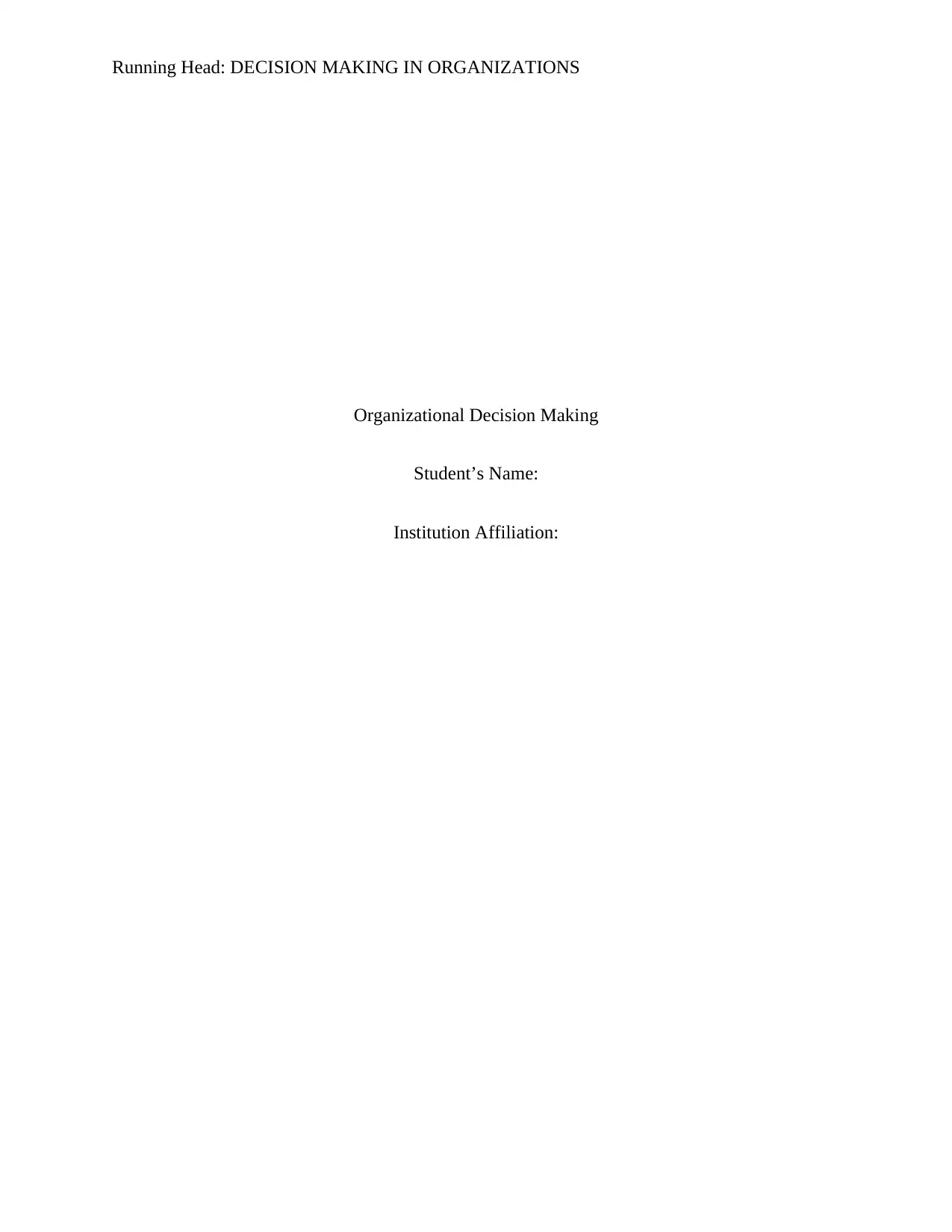
Running Head: DECISION MAKING IN ORGANIZATIONS
Organizational Decision Making
Student’s Name:
Institution Affiliation:
Organizational Decision Making
Student’s Name:
Institution Affiliation:
Secure Best Marks with AI Grader
Need help grading? Try our AI Grader for instant feedback on your assignments.
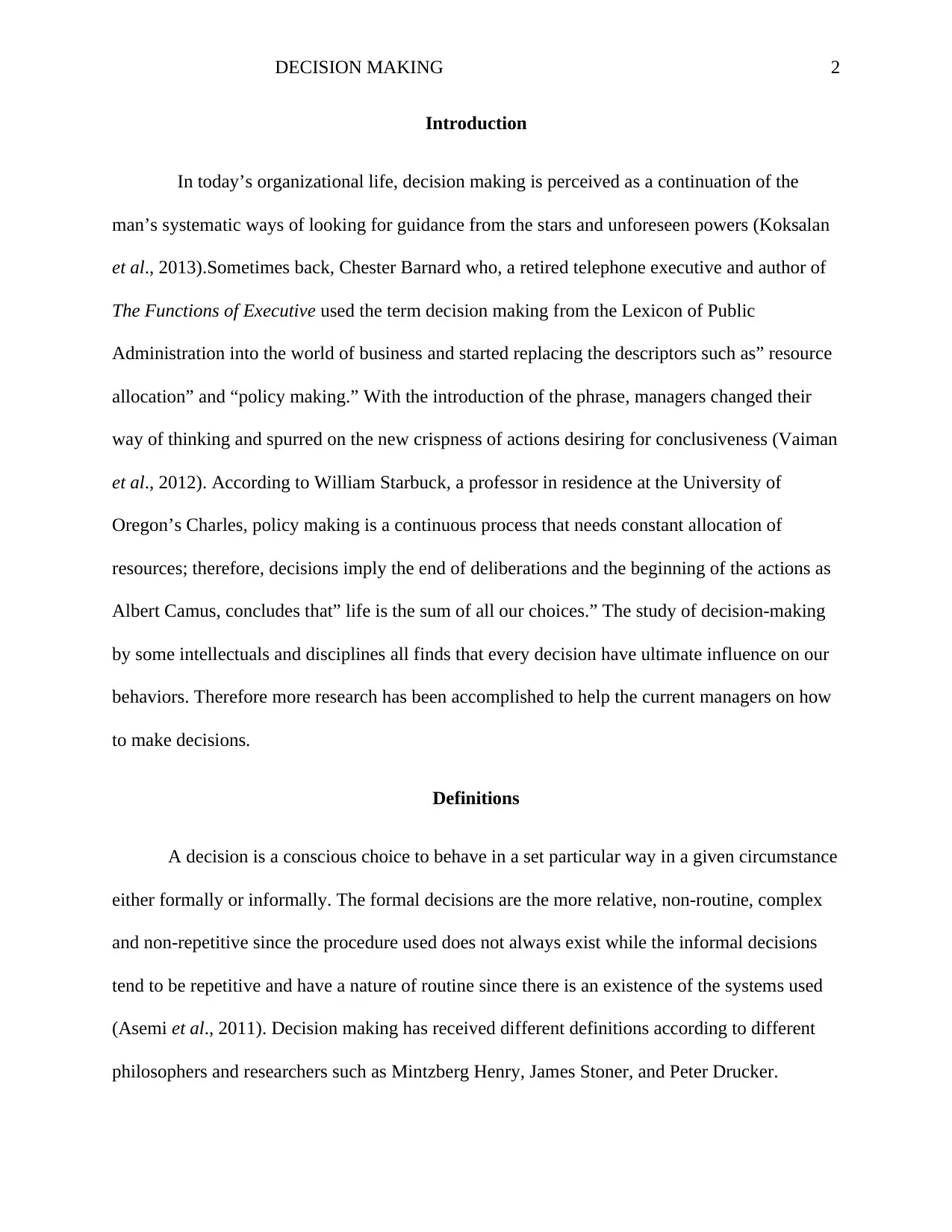
DECISION MAKING 2
Introduction
In today’s organizational life, decision making is perceived as a continuation of the
man’s systematic ways of looking for guidance from the stars and unforeseen powers (Koksalan
et al., 2013).Sometimes back, Chester Barnard who, a retired telephone executive and author of
The Functions of Executive used the term decision making from the Lexicon of Public
Administration into the world of business and started replacing the descriptors such as” resource
allocation” and “policy making.” With the introduction of the phrase, managers changed their
way of thinking and spurred on the new crispness of actions desiring for conclusiveness (Vaiman
et al., 2012). According to William Starbuck, a professor in residence at the University of
Oregon’s Charles, policy making is a continuous process that needs constant allocation of
resources; therefore, decisions imply the end of deliberations and the beginning of the actions as
Albert Camus, concludes that” life is the sum of all our choices.” The study of decision-making
by some intellectuals and disciplines all finds that every decision have ultimate influence on our
behaviors. Therefore more research has been accomplished to help the current managers on how
to make decisions.
Definitions
A decision is a conscious choice to behave in a set particular way in a given circumstance
either formally or informally. The formal decisions are the more relative, non-routine, complex
and non-repetitive since the procedure used does not always exist while the informal decisions
tend to be repetitive and have a nature of routine since there is an existence of the systems used
(Asemi et al., 2011). Decision making has received different definitions according to different
philosophers and researchers such as Mintzberg Henry, James Stoner, and Peter Drucker.
Introduction
In today’s organizational life, decision making is perceived as a continuation of the
man’s systematic ways of looking for guidance from the stars and unforeseen powers (Koksalan
et al., 2013).Sometimes back, Chester Barnard who, a retired telephone executive and author of
The Functions of Executive used the term decision making from the Lexicon of Public
Administration into the world of business and started replacing the descriptors such as” resource
allocation” and “policy making.” With the introduction of the phrase, managers changed their
way of thinking and spurred on the new crispness of actions desiring for conclusiveness (Vaiman
et al., 2012). According to William Starbuck, a professor in residence at the University of
Oregon’s Charles, policy making is a continuous process that needs constant allocation of
resources; therefore, decisions imply the end of deliberations and the beginning of the actions as
Albert Camus, concludes that” life is the sum of all our choices.” The study of decision-making
by some intellectuals and disciplines all finds that every decision have ultimate influence on our
behaviors. Therefore more research has been accomplished to help the current managers on how
to make decisions.
Definitions
A decision is a conscious choice to behave in a set particular way in a given circumstance
either formally or informally. The formal decisions are the more relative, non-routine, complex
and non-repetitive since the procedure used does not always exist while the informal decisions
tend to be repetitive and have a nature of routine since there is an existence of the systems used
(Asemi et al., 2011). Decision making has received different definitions according to different
philosophers and researchers such as Mintzberg Henry, James Stoner, and Peter Drucker.
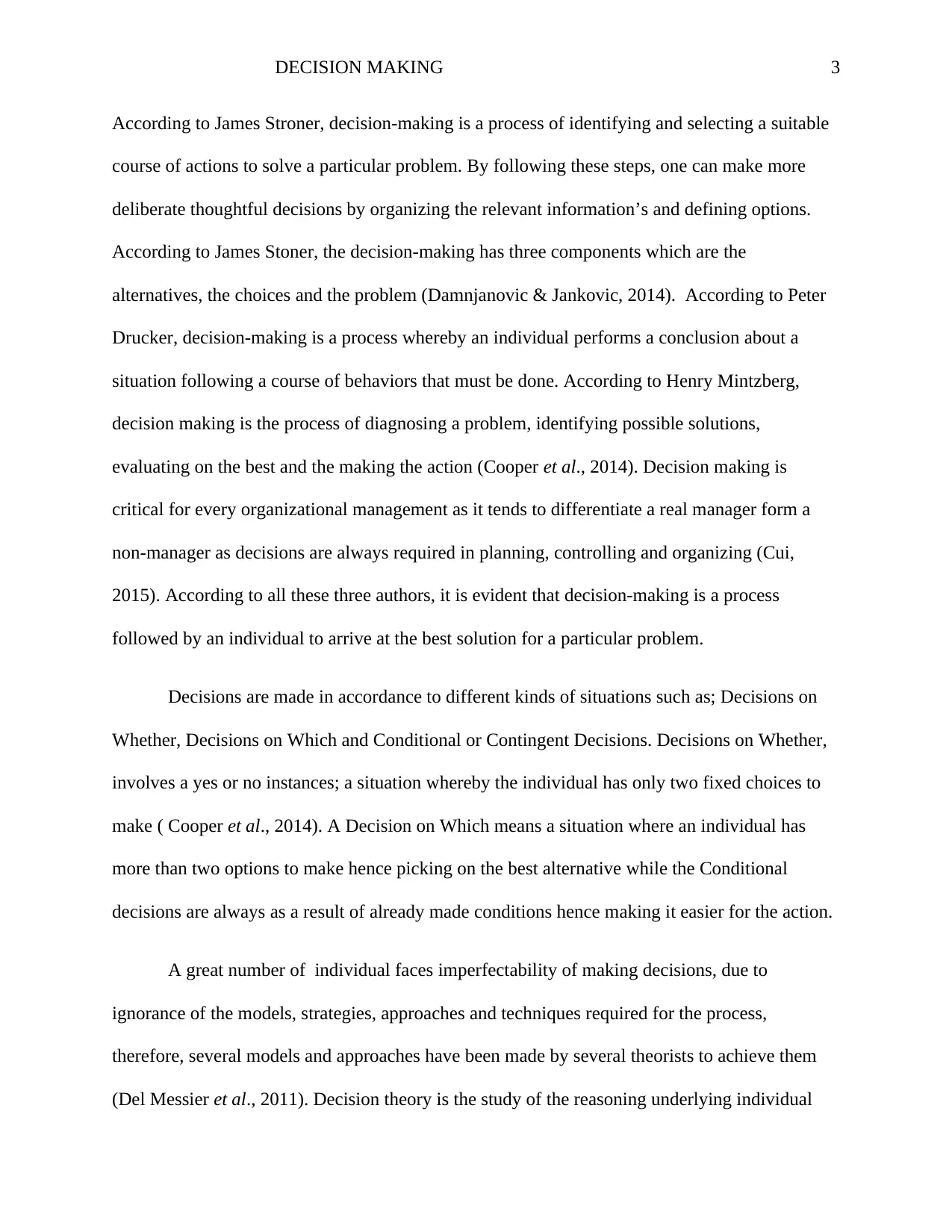
DECISION MAKING 3
According to James Stroner, decision-making is a process of identifying and selecting a suitable
course of actions to solve a particular problem. By following these steps, one can make more
deliberate thoughtful decisions by organizing the relevant information’s and defining options.
According to James Stoner, the decision-making has three components which are the
alternatives, the choices and the problem (Damnjanovic & Jankovic, 2014). According to Peter
Drucker, decision-making is a process whereby an individual performs a conclusion about a
situation following a course of behaviors that must be done. According to Henry Mintzberg,
decision making is the process of diagnosing a problem, identifying possible solutions,
evaluating on the best and the making the action (Cooper et al., 2014). Decision making is
critical for every organizational management as it tends to differentiate a real manager form a
non-manager as decisions are always required in planning, controlling and organizing (Cui,
2015). According to all these three authors, it is evident that decision-making is a process
followed by an individual to arrive at the best solution for a particular problem.
Decisions are made in accordance to different kinds of situations such as; Decisions on
Whether, Decisions on Which and Conditional or Contingent Decisions. Decisions on Whether,
involves a yes or no instances; a situation whereby the individual has only two fixed choices to
make ( Cooper et al., 2014). A Decision on Which means a situation where an individual has
more than two options to make hence picking on the best alternative while the Conditional
decisions are always as a result of already made conditions hence making it easier for the action.
A great number of individual faces imperfectability of making decisions, due to
ignorance of the models, strategies, approaches and techniques required for the process,
therefore, several models and approaches have been made by several theorists to achieve them
(Del Messier et al., 2011). Decision theory is the study of the reasoning underlying individual
According to James Stroner, decision-making is a process of identifying and selecting a suitable
course of actions to solve a particular problem. By following these steps, one can make more
deliberate thoughtful decisions by organizing the relevant information’s and defining options.
According to James Stoner, the decision-making has three components which are the
alternatives, the choices and the problem (Damnjanovic & Jankovic, 2014). According to Peter
Drucker, decision-making is a process whereby an individual performs a conclusion about a
situation following a course of behaviors that must be done. According to Henry Mintzberg,
decision making is the process of diagnosing a problem, identifying possible solutions,
evaluating on the best and the making the action (Cooper et al., 2014). Decision making is
critical for every organizational management as it tends to differentiate a real manager form a
non-manager as decisions are always required in planning, controlling and organizing (Cui,
2015). According to all these three authors, it is evident that decision-making is a process
followed by an individual to arrive at the best solution for a particular problem.
Decisions are made in accordance to different kinds of situations such as; Decisions on
Whether, Decisions on Which and Conditional or Contingent Decisions. Decisions on Whether,
involves a yes or no instances; a situation whereby the individual has only two fixed choices to
make ( Cooper et al., 2014). A Decision on Which means a situation where an individual has
more than two options to make hence picking on the best alternative while the Conditional
decisions are always as a result of already made conditions hence making it easier for the action.
A great number of individual faces imperfectability of making decisions, due to
ignorance of the models, strategies, approaches and techniques required for the process,
therefore, several models and approaches have been made by several theorists to achieve them
(Del Messier et al., 2011). Decision theory is the study of the reasoning underlying individual
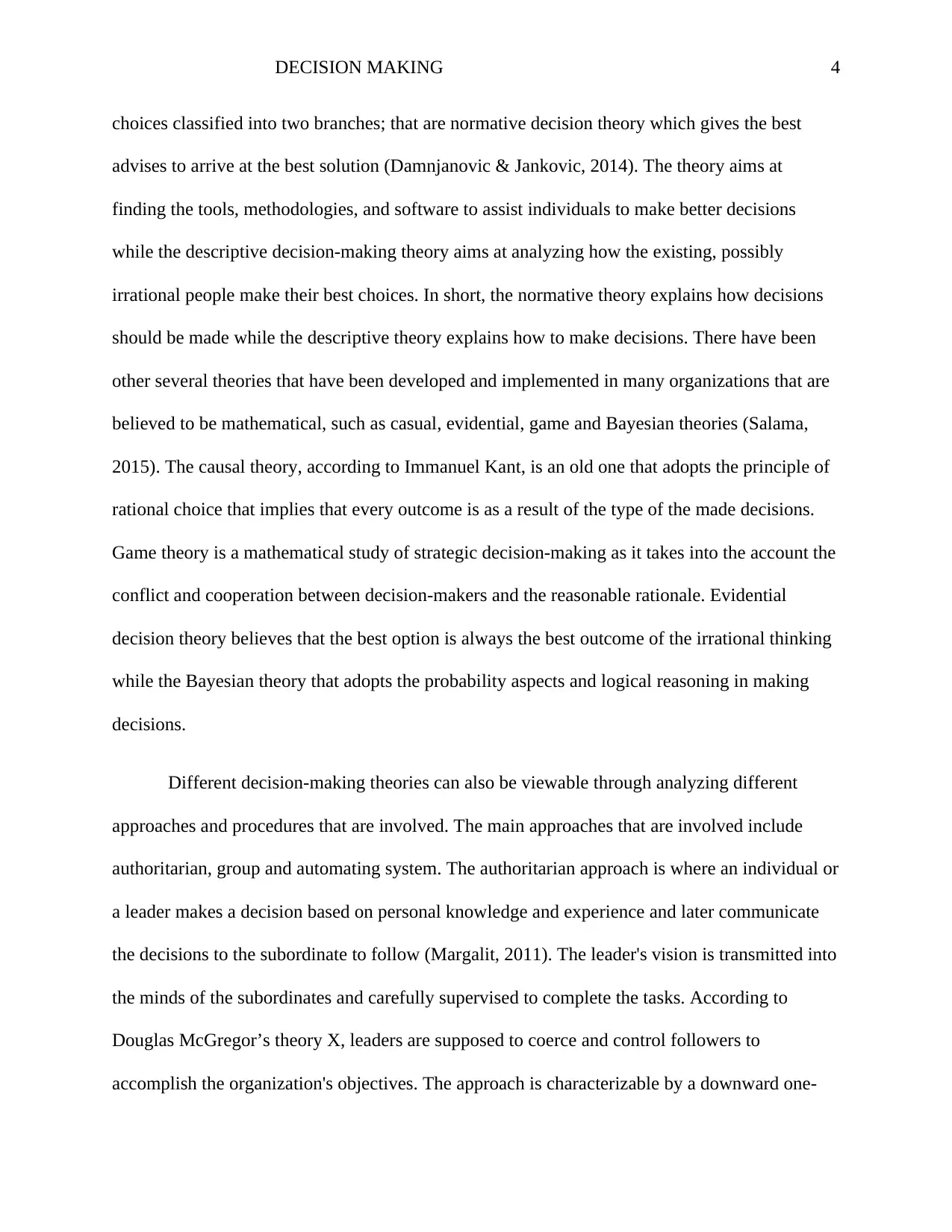
DECISION MAKING 4
choices classified into two branches; that are normative decision theory which gives the best
advises to arrive at the best solution (Damnjanovic & Jankovic, 2014). The theory aims at
finding the tools, methodologies, and software to assist individuals to make better decisions
while the descriptive decision-making theory aims at analyzing how the existing, possibly
irrational people make their best choices. In short, the normative theory explains how decisions
should be made while the descriptive theory explains how to make decisions. There have been
other several theories that have been developed and implemented in many organizations that are
believed to be mathematical, such as casual, evidential, game and Bayesian theories (Salama,
2015). The causal theory, according to Immanuel Kant, is an old one that adopts the principle of
rational choice that implies that every outcome is as a result of the type of the made decisions.
Game theory is a mathematical study of strategic decision-making as it takes into the account the
conflict and cooperation between decision-makers and the reasonable rationale. Evidential
decision theory believes that the best option is always the best outcome of the irrational thinking
while the Bayesian theory that adopts the probability aspects and logical reasoning in making
decisions.
Different decision-making theories can also be viewable through analyzing different
approaches and procedures that are involved. The main approaches that are involved include
authoritarian, group and automating system. The authoritarian approach is where an individual or
a leader makes a decision based on personal knowledge and experience and later communicate
the decisions to the subordinate to follow (Margalit, 2011). The leader's vision is transmitted into
the minds of the subordinates and carefully supervised to complete the tasks. According to
Douglas McGregor’s theory X, leaders are supposed to coerce and control followers to
accomplish the organization's objectives. The approach is characterizable by a downward one-
choices classified into two branches; that are normative decision theory which gives the best
advises to arrive at the best solution (Damnjanovic & Jankovic, 2014). The theory aims at
finding the tools, methodologies, and software to assist individuals to make better decisions
while the descriptive decision-making theory aims at analyzing how the existing, possibly
irrational people make their best choices. In short, the normative theory explains how decisions
should be made while the descriptive theory explains how to make decisions. There have been
other several theories that have been developed and implemented in many organizations that are
believed to be mathematical, such as casual, evidential, game and Bayesian theories (Salama,
2015). The causal theory, according to Immanuel Kant, is an old one that adopts the principle of
rational choice that implies that every outcome is as a result of the type of the made decisions.
Game theory is a mathematical study of strategic decision-making as it takes into the account the
conflict and cooperation between decision-makers and the reasonable rationale. Evidential
decision theory believes that the best option is always the best outcome of the irrational thinking
while the Bayesian theory that adopts the probability aspects and logical reasoning in making
decisions.
Different decision-making theories can also be viewable through analyzing different
approaches and procedures that are involved. The main approaches that are involved include
authoritarian, group and automating system. The authoritarian approach is where an individual or
a leader makes a decision based on personal knowledge and experience and later communicate
the decisions to the subordinate to follow (Margalit, 2011). The leader's vision is transmitted into
the minds of the subordinates and carefully supervised to complete the tasks. According to
Douglas McGregor’s theory X, leaders are supposed to coerce and control followers to
accomplish the organization's objectives. The approach is characterizable by a downward one-
Secure Best Marks with AI Grader
Need help grading? Try our AI Grader for instant feedback on your assignments.
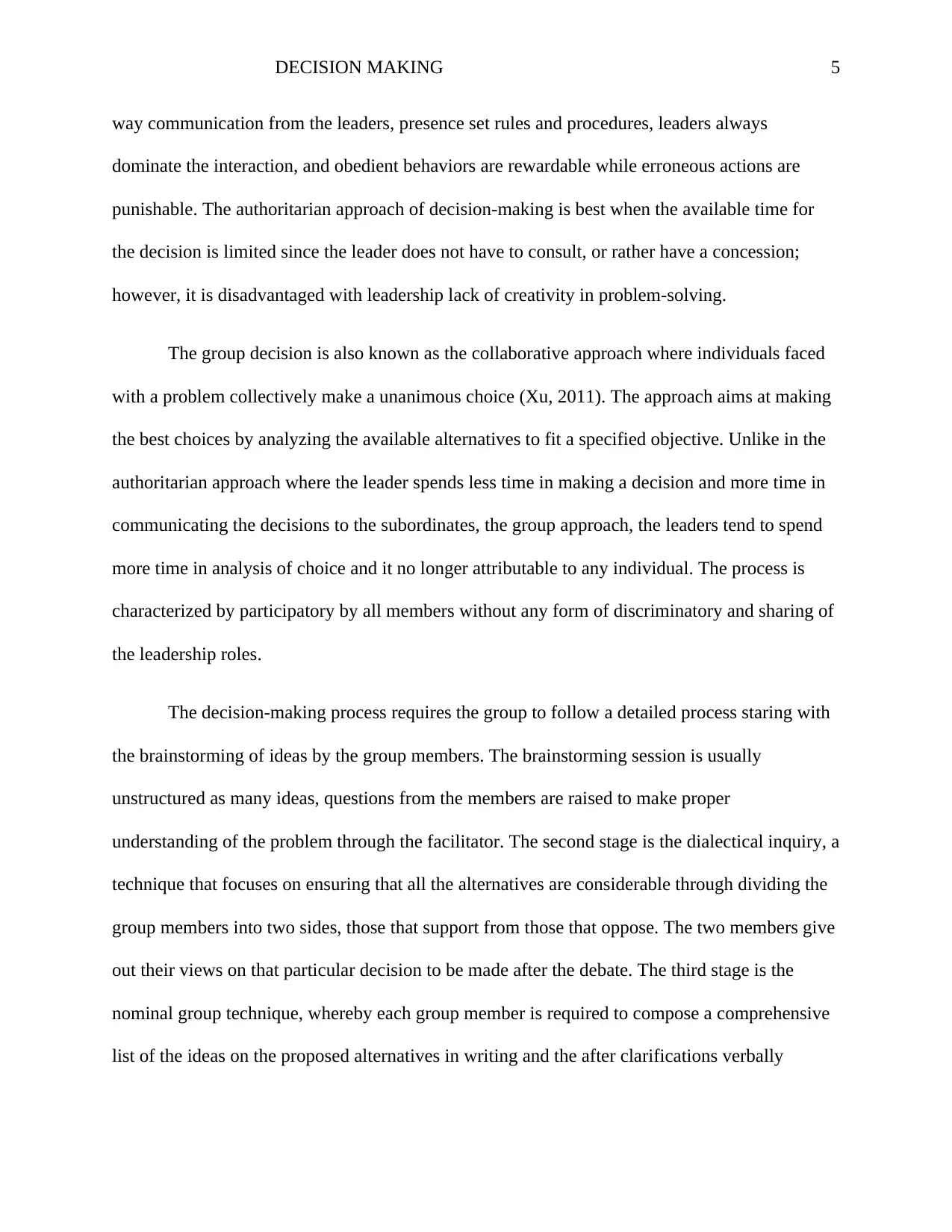
DECISION MAKING 5
way communication from the leaders, presence set rules and procedures, leaders always
dominate the interaction, and obedient behaviors are rewardable while erroneous actions are
punishable. The authoritarian approach of decision-making is best when the available time for
the decision is limited since the leader does not have to consult, or rather have a concession;
however, it is disadvantaged with leadership lack of creativity in problem-solving.
The group decision is also known as the collaborative approach where individuals faced
with a problem collectively make a unanimous choice (Xu, 2011). The approach aims at making
the best choices by analyzing the available alternatives to fit a specified objective. Unlike in the
authoritarian approach where the leader spends less time in making a decision and more time in
communicating the decisions to the subordinates, the group approach, the leaders tend to spend
more time in analysis of choice and it no longer attributable to any individual. The process is
characterized by participatory by all members without any form of discriminatory and sharing of
the leadership roles.
The decision-making process requires the group to follow a detailed process staring with
the brainstorming of ideas by the group members. The brainstorming session is usually
unstructured as many ideas, questions from the members are raised to make proper
understanding of the problem through the facilitator. The second stage is the dialectical inquiry, a
technique that focuses on ensuring that all the alternatives are considerable through dividing the
group members into two sides, those that support from those that oppose. The two members give
out their views on that particular decision to be made after the debate. The third stage is the
nominal group technique, whereby each group member is required to compose a comprehensive
list of the ideas on the proposed alternatives in writing and the after clarifications verbally
way communication from the leaders, presence set rules and procedures, leaders always
dominate the interaction, and obedient behaviors are rewardable while erroneous actions are
punishable. The authoritarian approach of decision-making is best when the available time for
the decision is limited since the leader does not have to consult, or rather have a concession;
however, it is disadvantaged with leadership lack of creativity in problem-solving.
The group decision is also known as the collaborative approach where individuals faced
with a problem collectively make a unanimous choice (Xu, 2011). The approach aims at making
the best choices by analyzing the available alternatives to fit a specified objective. Unlike in the
authoritarian approach where the leader spends less time in making a decision and more time in
communicating the decisions to the subordinates, the group approach, the leaders tend to spend
more time in analysis of choice and it no longer attributable to any individual. The process is
characterized by participatory by all members without any form of discriminatory and sharing of
the leadership roles.
The decision-making process requires the group to follow a detailed process staring with
the brainstorming of ideas by the group members. The brainstorming session is usually
unstructured as many ideas, questions from the members are raised to make proper
understanding of the problem through the facilitator. The second stage is the dialectical inquiry, a
technique that focuses on ensuring that all the alternatives are considerable through dividing the
group members into two sides, those that support from those that oppose. The two members give
out their views on that particular decision to be made after the debate. The third stage is the
nominal group technique, whereby each group member is required to compose a comprehensive
list of the ideas on the proposed alternatives in writing and the after clarifications verbally
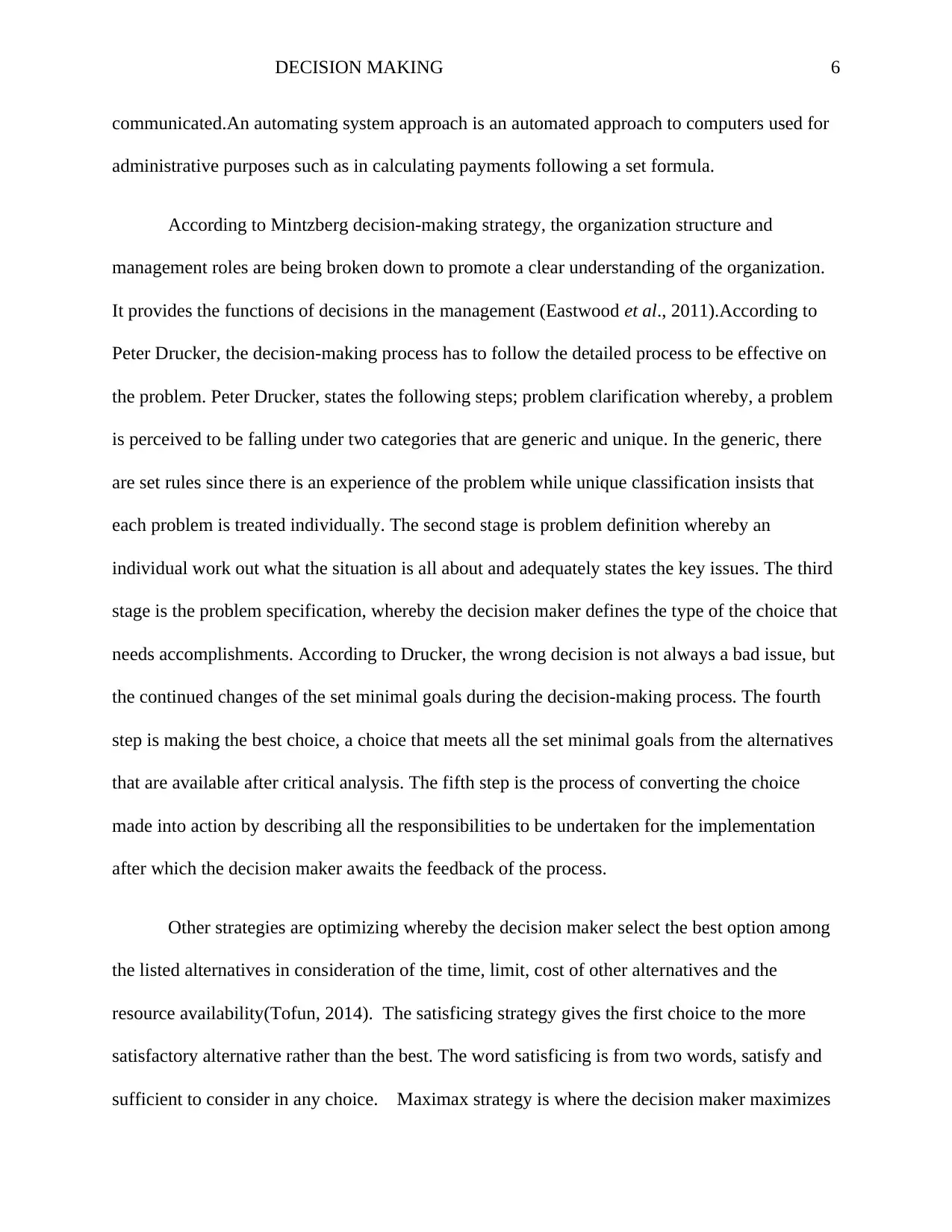
DECISION MAKING 6
communicated.An automating system approach is an automated approach to computers used for
administrative purposes such as in calculating payments following a set formula.
According to Mintzberg decision-making strategy, the organization structure and
management roles are being broken down to promote a clear understanding of the organization.
It provides the functions of decisions in the management (Eastwood et al., 2011).According to
Peter Drucker, the decision-making process has to follow the detailed process to be effective on
the problem. Peter Drucker, states the following steps; problem clarification whereby, a problem
is perceived to be falling under two categories that are generic and unique. In the generic, there
are set rules since there is an experience of the problem while unique classification insists that
each problem is treated individually. The second stage is problem definition whereby an
individual work out what the situation is all about and adequately states the key issues. The third
stage is the problem specification, whereby the decision maker defines the type of the choice that
needs accomplishments. According to Drucker, the wrong decision is not always a bad issue, but
the continued changes of the set minimal goals during the decision-making process. The fourth
step is making the best choice, a choice that meets all the set minimal goals from the alternatives
that are available after critical analysis. The fifth step is the process of converting the choice
made into action by describing all the responsibilities to be undertaken for the implementation
after which the decision maker awaits the feedback of the process.
Other strategies are optimizing whereby the decision maker select the best option among
the listed alternatives in consideration of the time, limit, cost of other alternatives and the
resource availability(Tofun, 2014). The satisficing strategy gives the first choice to the more
satisfactory alternative rather than the best. The word satisficing is from two words, satisfy and
sufficient to consider in any choice. Maximax strategy is where the decision maker maximizes
communicated.An automating system approach is an automated approach to computers used for
administrative purposes such as in calculating payments following a set formula.
According to Mintzberg decision-making strategy, the organization structure and
management roles are being broken down to promote a clear understanding of the organization.
It provides the functions of decisions in the management (Eastwood et al., 2011).According to
Peter Drucker, the decision-making process has to follow the detailed process to be effective on
the problem. Peter Drucker, states the following steps; problem clarification whereby, a problem
is perceived to be falling under two categories that are generic and unique. In the generic, there
are set rules since there is an experience of the problem while unique classification insists that
each problem is treated individually. The second stage is problem definition whereby an
individual work out what the situation is all about and adequately states the key issues. The third
stage is the problem specification, whereby the decision maker defines the type of the choice that
needs accomplishments. According to Drucker, the wrong decision is not always a bad issue, but
the continued changes of the set minimal goals during the decision-making process. The fourth
step is making the best choice, a choice that meets all the set minimal goals from the alternatives
that are available after critical analysis. The fifth step is the process of converting the choice
made into action by describing all the responsibilities to be undertaken for the implementation
after which the decision maker awaits the feedback of the process.
Other strategies are optimizing whereby the decision maker select the best option among
the listed alternatives in consideration of the time, limit, cost of other alternatives and the
resource availability(Tofun, 2014). The satisficing strategy gives the first choice to the more
satisfactory alternative rather than the best. The word satisficing is from two words, satisfy and
sufficient to consider in any choice. Maximax strategy is where the decision maker maximizes
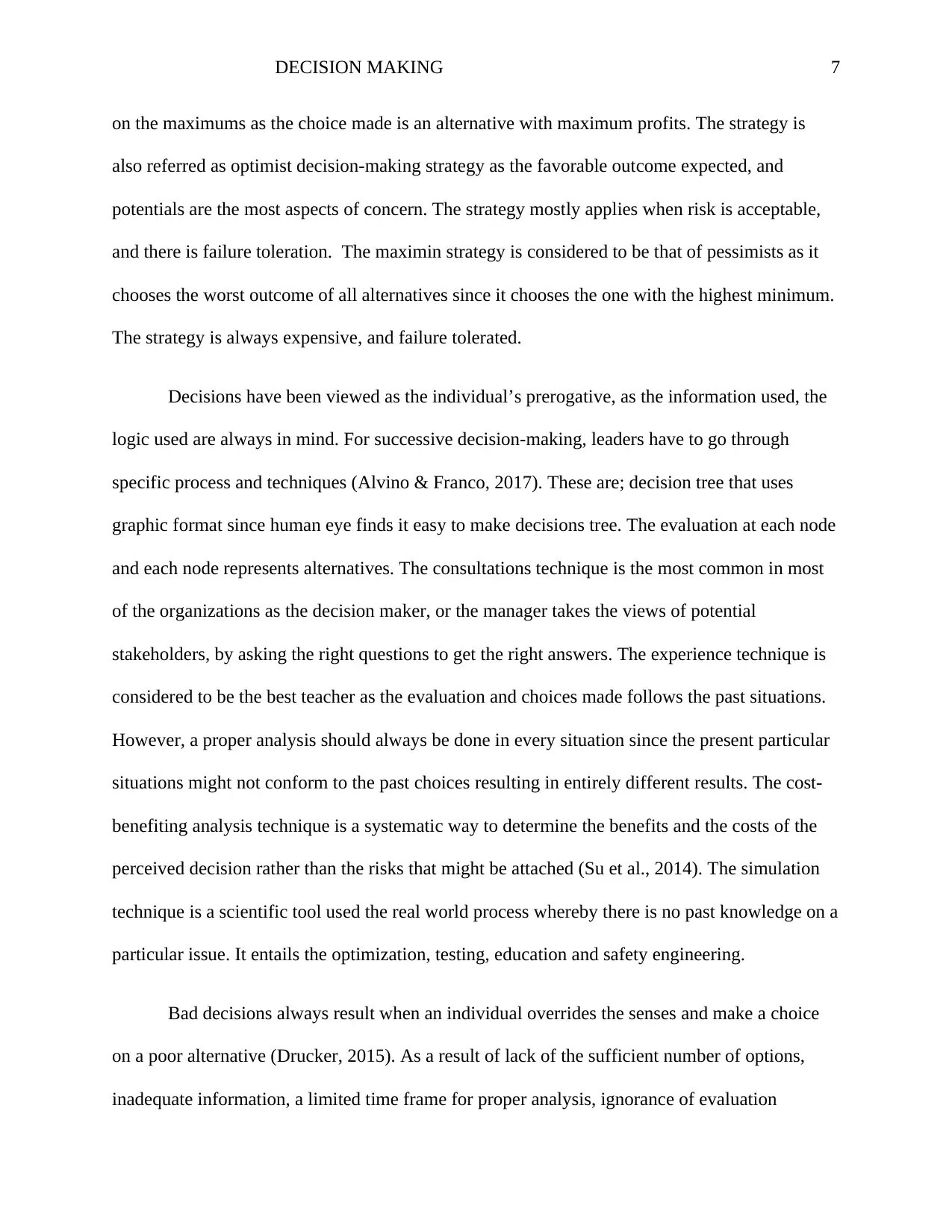
DECISION MAKING 7
on the maximums as the choice made is an alternative with maximum profits. The strategy is
also referred as optimist decision-making strategy as the favorable outcome expected, and
potentials are the most aspects of concern. The strategy mostly applies when risk is acceptable,
and there is failure toleration. The maximin strategy is considered to be that of pessimists as it
chooses the worst outcome of all alternatives since it chooses the one with the highest minimum.
The strategy is always expensive, and failure tolerated.
Decisions have been viewed as the individual’s prerogative, as the information used, the
logic used are always in mind. For successive decision-making, leaders have to go through
specific process and techniques (Alvino & Franco, 2017). These are; decision tree that uses
graphic format since human eye finds it easy to make decisions tree. The evaluation at each node
and each node represents alternatives. The consultations technique is the most common in most
of the organizations as the decision maker, or the manager takes the views of potential
stakeholders, by asking the right questions to get the right answers. The experience technique is
considered to be the best teacher as the evaluation and choices made follows the past situations.
However, a proper analysis should always be done in every situation since the present particular
situations might not conform to the past choices resulting in entirely different results. The cost-
benefiting analysis technique is a systematic way to determine the benefits and the costs of the
perceived decision rather than the risks that might be attached (Su et al., 2014). The simulation
technique is a scientific tool used the real world process whereby there is no past knowledge on a
particular issue. It entails the optimization, testing, education and safety engineering.
Bad decisions always result when an individual overrides the senses and make a choice
on a poor alternative (Drucker, 2015). As a result of lack of the sufficient number of options,
inadequate information, a limited time frame for proper analysis, ignorance of evaluation
on the maximums as the choice made is an alternative with maximum profits. The strategy is
also referred as optimist decision-making strategy as the favorable outcome expected, and
potentials are the most aspects of concern. The strategy mostly applies when risk is acceptable,
and there is failure toleration. The maximin strategy is considered to be that of pessimists as it
chooses the worst outcome of all alternatives since it chooses the one with the highest minimum.
The strategy is always expensive, and failure tolerated.
Decisions have been viewed as the individual’s prerogative, as the information used, the
logic used are always in mind. For successive decision-making, leaders have to go through
specific process and techniques (Alvino & Franco, 2017). These are; decision tree that uses
graphic format since human eye finds it easy to make decisions tree. The evaluation at each node
and each node represents alternatives. The consultations technique is the most common in most
of the organizations as the decision maker, or the manager takes the views of potential
stakeholders, by asking the right questions to get the right answers. The experience technique is
considered to be the best teacher as the evaluation and choices made follows the past situations.
However, a proper analysis should always be done in every situation since the present particular
situations might not conform to the past choices resulting in entirely different results. The cost-
benefiting analysis technique is a systematic way to determine the benefits and the costs of the
perceived decision rather than the risks that might be attached (Su et al., 2014). The simulation
technique is a scientific tool used the real world process whereby there is no past knowledge on a
particular issue. It entails the optimization, testing, education and safety engineering.
Bad decisions always result when an individual overrides the senses and make a choice
on a poor alternative (Drucker, 2015). As a result of lack of the sufficient number of options,
inadequate information, a limited time frame for proper analysis, ignorance of evaluation
Paraphrase This Document
Need a fresh take? Get an instant paraphrase of this document with our AI Paraphraser
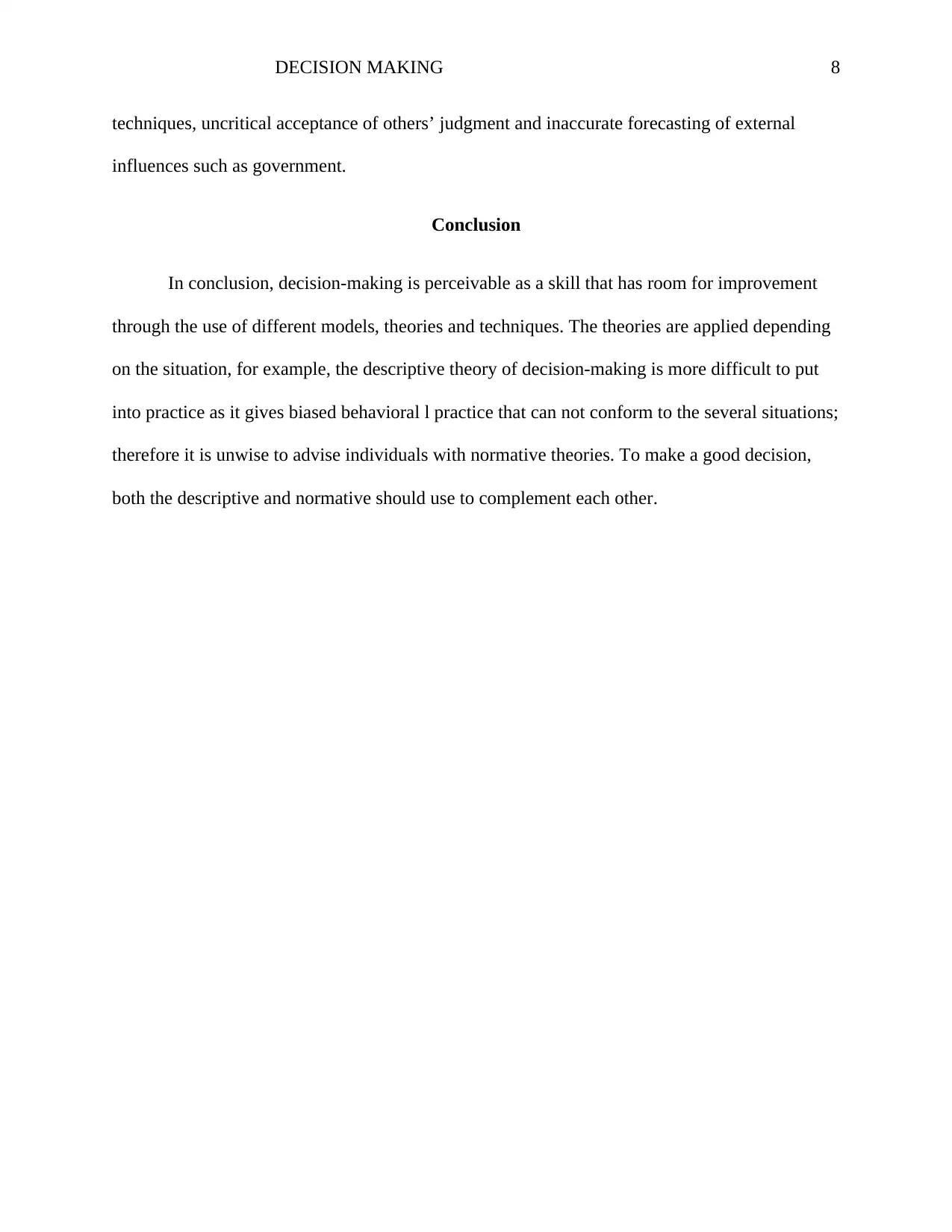
DECISION MAKING 8
techniques, uncritical acceptance of others’ judgment and inaccurate forecasting of external
influences such as government.
Conclusion
In conclusion, decision-making is perceivable as a skill that has room for improvement
through the use of different models, theories and techniques. The theories are applied depending
on the situation, for example, the descriptive theory of decision-making is more difficult to put
into practice as it gives biased behavioral l practice that can not conform to the several situations;
therefore it is unwise to advise individuals with normative theories. To make a good decision,
both the descriptive and normative should use to complement each other.
techniques, uncritical acceptance of others’ judgment and inaccurate forecasting of external
influences such as government.
Conclusion
In conclusion, decision-making is perceivable as a skill that has room for improvement
through the use of different models, theories and techniques. The theories are applied depending
on the situation, for example, the descriptive theory of decision-making is more difficult to put
into practice as it gives biased behavioral l practice that can not conform to the several situations;
therefore it is unwise to advise individuals with normative theories. To make a good decision,
both the descriptive and normative should use to complement each other.
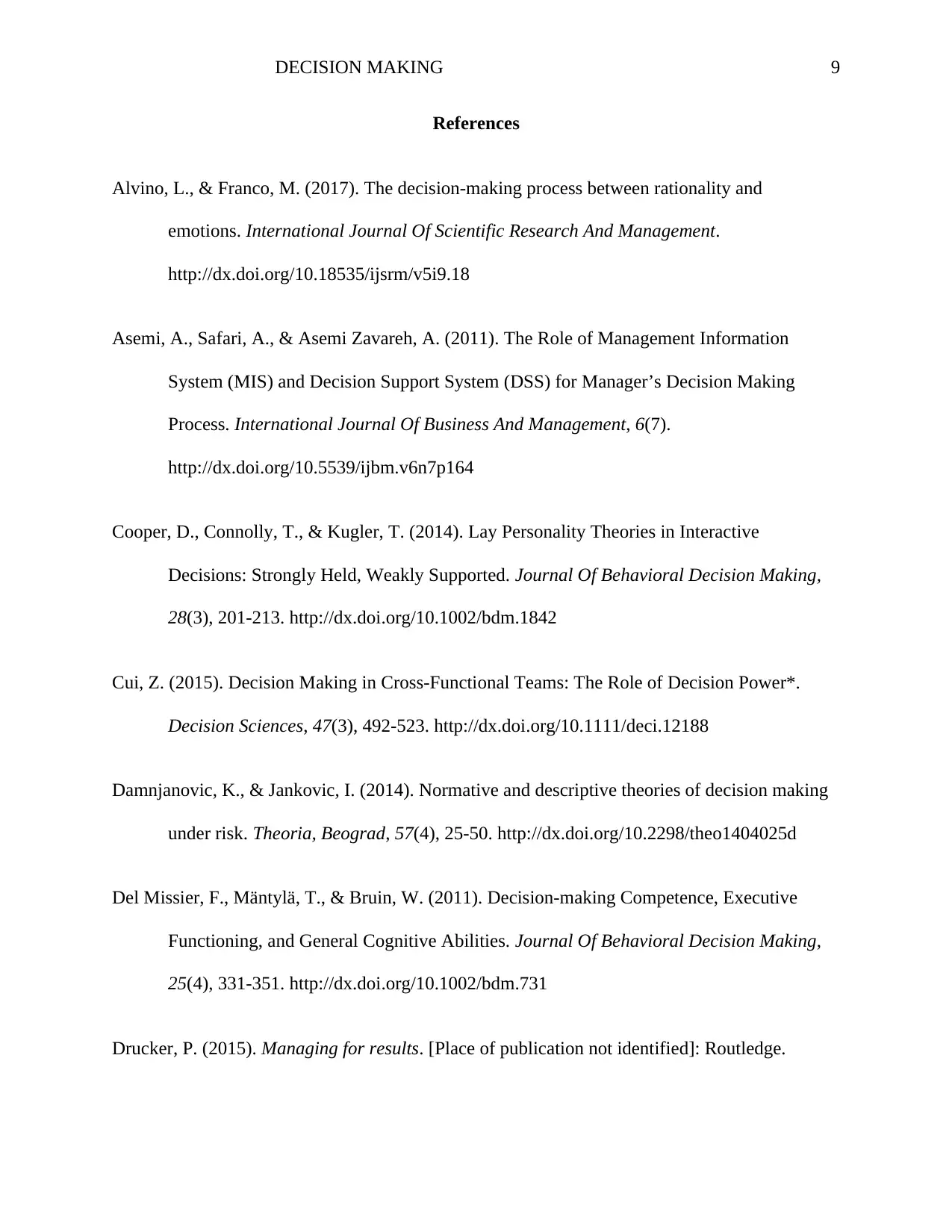
DECISION MAKING 9
References
Alvino, L., & Franco, M. (2017). The decision-making process between rationality and
emotions. International Journal Of Scientific Research And Management.
http://dx.doi.org/10.18535/ijsrm/v5i9.18
Asemi, A., Safari, A., & Asemi Zavareh, A. (2011). The Role of Management Information
System (MIS) and Decision Support System (DSS) for Manager’s Decision Making
Process. International Journal Of Business And Management, 6(7).
http://dx.doi.org/10.5539/ijbm.v6n7p164
Cooper, D., Connolly, T., & Kugler, T. (2014). Lay Personality Theories in Interactive
Decisions: Strongly Held, Weakly Supported. Journal Of Behavioral Decision Making,
28(3), 201-213. http://dx.doi.org/10.1002/bdm.1842
Cui, Z. (2015). Decision Making in Cross-Functional Teams: The Role of Decision Power*.
Decision Sciences, 47(3), 492-523. http://dx.doi.org/10.1111/deci.12188
Damnjanovic, K., & Jankovic, I. (2014). Normative and descriptive theories of decision making
under risk. Theoria, Beograd, 57(4), 25-50. http://dx.doi.org/10.2298/theo1404025d
Del Missier, F., Mäntylä, T., & Bruin, W. (2011). Decision-making Competence, Executive
Functioning, and General Cognitive Abilities. Journal Of Behavioral Decision Making,
25(4), 331-351. http://dx.doi.org/10.1002/bdm.731
Drucker, P. (2015). Managing for results. [Place of publication not identified]: Routledge.
References
Alvino, L., & Franco, M. (2017). The decision-making process between rationality and
emotions. International Journal Of Scientific Research And Management.
http://dx.doi.org/10.18535/ijsrm/v5i9.18
Asemi, A., Safari, A., & Asemi Zavareh, A. (2011). The Role of Management Information
System (MIS) and Decision Support System (DSS) for Manager’s Decision Making
Process. International Journal Of Business And Management, 6(7).
http://dx.doi.org/10.5539/ijbm.v6n7p164
Cooper, D., Connolly, T., & Kugler, T. (2014). Lay Personality Theories in Interactive
Decisions: Strongly Held, Weakly Supported. Journal Of Behavioral Decision Making,
28(3), 201-213. http://dx.doi.org/10.1002/bdm.1842
Cui, Z. (2015). Decision Making in Cross-Functional Teams: The Role of Decision Power*.
Decision Sciences, 47(3), 492-523. http://dx.doi.org/10.1111/deci.12188
Damnjanovic, K., & Jankovic, I. (2014). Normative and descriptive theories of decision making
under risk. Theoria, Beograd, 57(4), 25-50. http://dx.doi.org/10.2298/theo1404025d
Del Missier, F., Mäntylä, T., & Bruin, W. (2011). Decision-making Competence, Executive
Functioning, and General Cognitive Abilities. Journal Of Behavioral Decision Making,
25(4), 331-351. http://dx.doi.org/10.1002/bdm.731
Drucker, P. (2015). Managing for results. [Place of publication not identified]: Routledge.
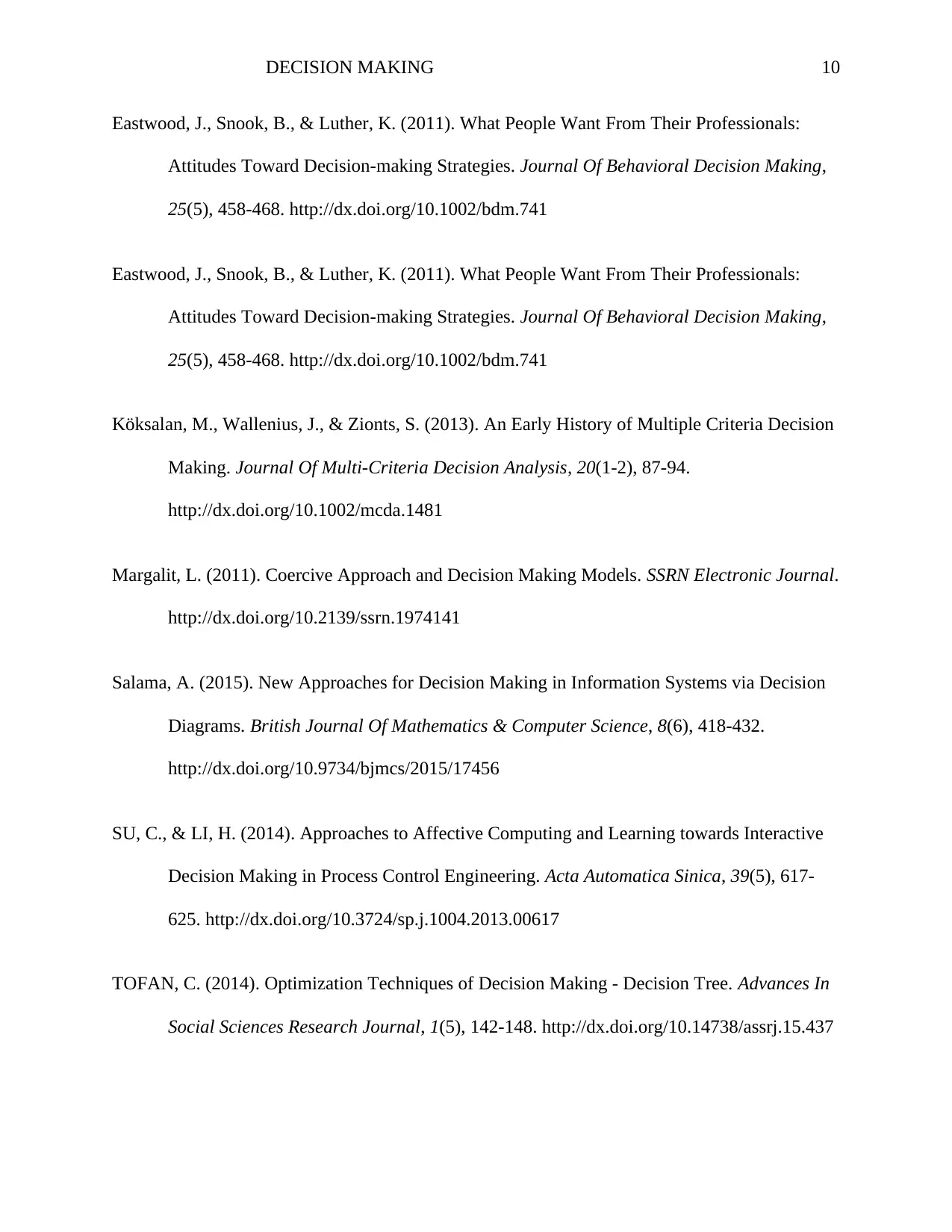
DECISION MAKING 10
Eastwood, J., Snook, B., & Luther, K. (2011). What People Want From Their Professionals:
Attitudes Toward Decision-making Strategies. Journal Of Behavioral Decision Making,
25(5), 458-468. http://dx.doi.org/10.1002/bdm.741
Eastwood, J., Snook, B., & Luther, K. (2011). What People Want From Their Professionals:
Attitudes Toward Decision-making Strategies. Journal Of Behavioral Decision Making,
25(5), 458-468. http://dx.doi.org/10.1002/bdm.741
Köksalan, M., Wallenius, J., & Zionts, S. (2013). An Early History of Multiple Criteria Decision
Making. Journal Of Multi-Criteria Decision Analysis, 20(1-2), 87-94.
http://dx.doi.org/10.1002/mcda.1481
Margalit, L. (2011). Coercive Approach and Decision Making Models. SSRN Electronic Journal.
http://dx.doi.org/10.2139/ssrn.1974141
Salama, A. (2015). New Approaches for Decision Making in Information Systems via Decision
Diagrams. British Journal Of Mathematics & Computer Science, 8(6), 418-432.
http://dx.doi.org/10.9734/bjmcs/2015/17456
SU, C., & LI, H. (2014). Approaches to Affective Computing and Learning towards Interactive
Decision Making in Process Control Engineering. Acta Automatica Sinica, 39(5), 617-
625. http://dx.doi.org/10.3724/sp.j.1004.2013.00617
TOFAN, C. (2014). Optimization Techniques of Decision Making - Decision Tree. Advances In
Social Sciences Research Journal, 1(5), 142-148. http://dx.doi.org/10.14738/assrj.15.437
Eastwood, J., Snook, B., & Luther, K. (2011). What People Want From Their Professionals:
Attitudes Toward Decision-making Strategies. Journal Of Behavioral Decision Making,
25(5), 458-468. http://dx.doi.org/10.1002/bdm.741
Eastwood, J., Snook, B., & Luther, K. (2011). What People Want From Their Professionals:
Attitudes Toward Decision-making Strategies. Journal Of Behavioral Decision Making,
25(5), 458-468. http://dx.doi.org/10.1002/bdm.741
Köksalan, M., Wallenius, J., & Zionts, S. (2013). An Early History of Multiple Criteria Decision
Making. Journal Of Multi-Criteria Decision Analysis, 20(1-2), 87-94.
http://dx.doi.org/10.1002/mcda.1481
Margalit, L. (2011). Coercive Approach and Decision Making Models. SSRN Electronic Journal.
http://dx.doi.org/10.2139/ssrn.1974141
Salama, A. (2015). New Approaches for Decision Making in Information Systems via Decision
Diagrams. British Journal Of Mathematics & Computer Science, 8(6), 418-432.
http://dx.doi.org/10.9734/bjmcs/2015/17456
SU, C., & LI, H. (2014). Approaches to Affective Computing and Learning towards Interactive
Decision Making in Process Control Engineering. Acta Automatica Sinica, 39(5), 617-
625. http://dx.doi.org/10.3724/sp.j.1004.2013.00617
TOFAN, C. (2014). Optimization Techniques of Decision Making - Decision Tree. Advances In
Social Sciences Research Journal, 1(5), 142-148. http://dx.doi.org/10.14738/assrj.15.437
Secure Best Marks with AI Grader
Need help grading? Try our AI Grader for instant feedback on your assignments.
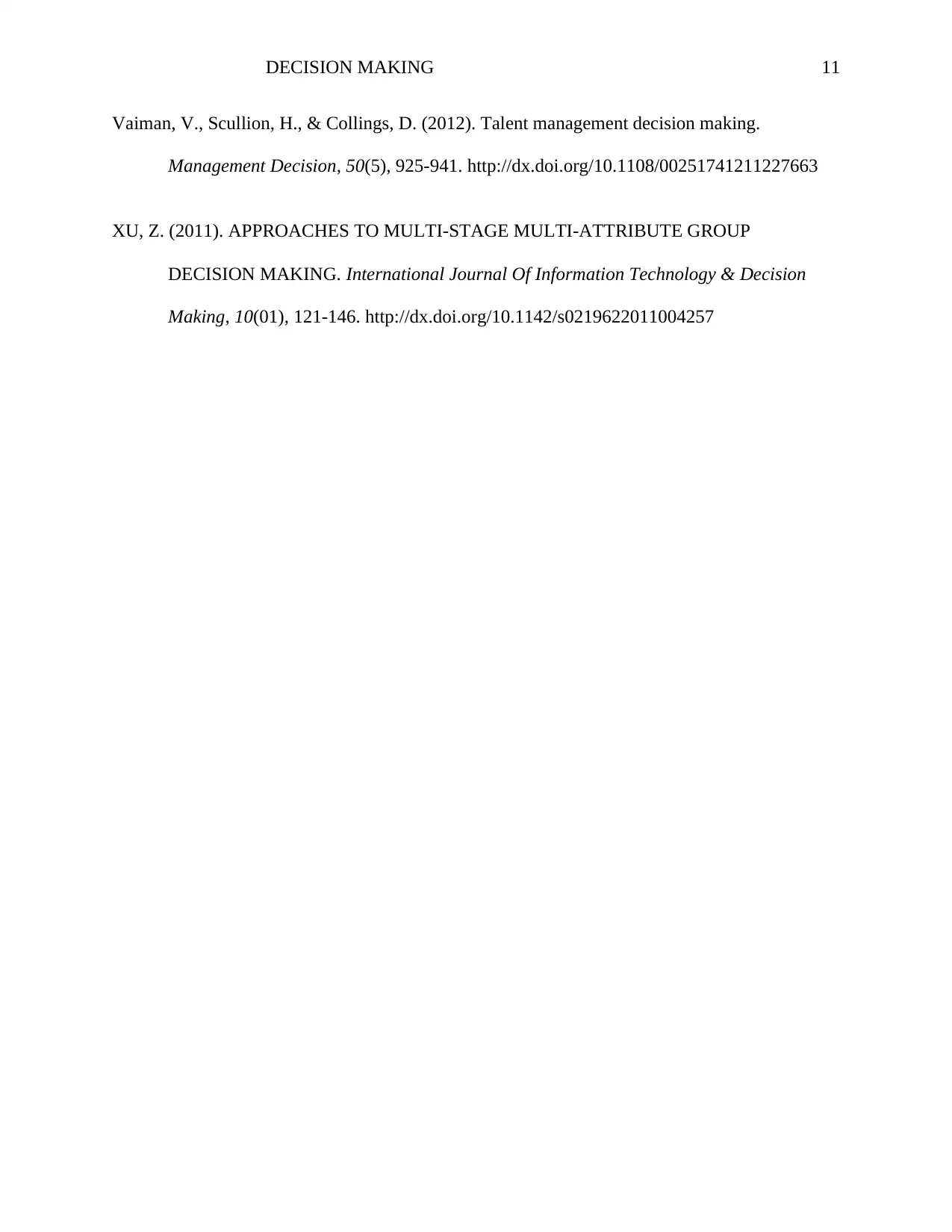
DECISION MAKING 11
Vaiman, V., Scullion, H., & Collings, D. (2012). Talent management decision making.
Management Decision, 50(5), 925-941. http://dx.doi.org/10.1108/00251741211227663
XU, Z. (2011). APPROACHES TO MULTI-STAGE MULTI-ATTRIBUTE GROUP
DECISION MAKING. International Journal Of Information Technology & Decision
Making, 10(01), 121-146. http://dx.doi.org/10.1142/s0219622011004257
Vaiman, V., Scullion, H., & Collings, D. (2012). Talent management decision making.
Management Decision, 50(5), 925-941. http://dx.doi.org/10.1108/00251741211227663
XU, Z. (2011). APPROACHES TO MULTI-STAGE MULTI-ATTRIBUTE GROUP
DECISION MAKING. International Journal Of Information Technology & Decision
Making, 10(01), 121-146. http://dx.doi.org/10.1142/s0219622011004257
1 out of 11
Your All-in-One AI-Powered Toolkit for Academic Success.
+13062052269
info@desklib.com
Available 24*7 on WhatsApp / Email
![[object Object]](/_next/static/media/star-bottom.7253800d.svg)
Unlock your academic potential
© 2024 | Zucol Services PVT LTD | All rights reserved.


